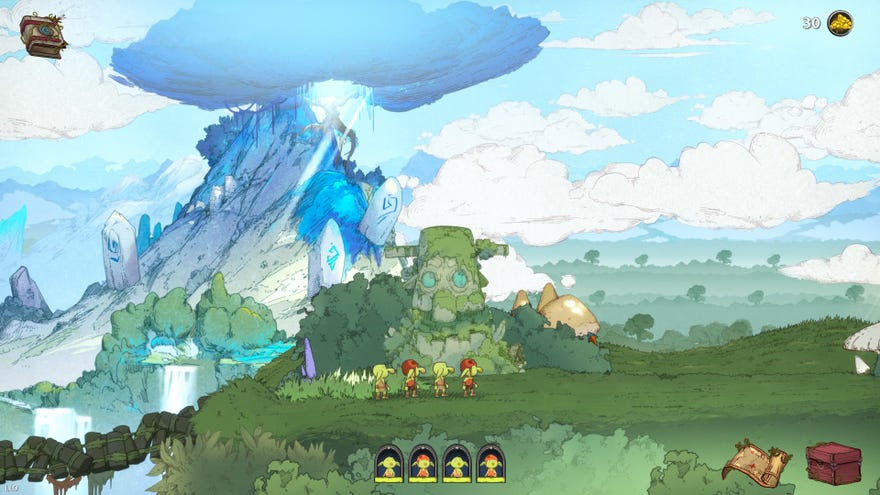Goblin Stone review: turn-based charm spells only last so long
Goblin’ up my patience more like
In the world of strategy and management game Goblin Stone, the goblins are nearly extinct. Getting murdered in large numbers by adventurers hungry for a quick experience point and a slack handful of coin will do that. I cannot tell you that you will want to bestow protection and prosperity on these gribbly green niblets. They exhibit a tweeness that you’ll either find charming or despicably manipulative, even when they’re showering in the blood of their enemies. Should you want to, though, Goblin Stone offers you the chance to rescue these maligned misfits from the brink of extinction, rebuilding their kingdom and leading them on outings to take the fight to all those heroes that have spotlight-hogged the left side of your screens for far too long.
These outings see your six goblin troupe exploring the land and fighting turn-based battles, collecting both base building resources and personal treasures. There are also more unique encounters, like testing your party’s stats against a trio of rogue chefs wielding a mysterious ham. You’re privy to a (vaguely Slayish, somewhat Spirelike) full map right from the start, so you can plan routes depending on what you want to gain from an outing. Early on, these choices are fairly straightforward: do you pick a regular fight for treasure? Or a harder one for more treasure? Soon, you’ll find yourself going on runs specifically to hoard a certain resource, like bone or wood, so you might prioritise gathering spots. Or, you might run into a nasty boss, lose, and know to hit as many vendors, treasure chests, or blessing shrines as you can in the next run to prepare.
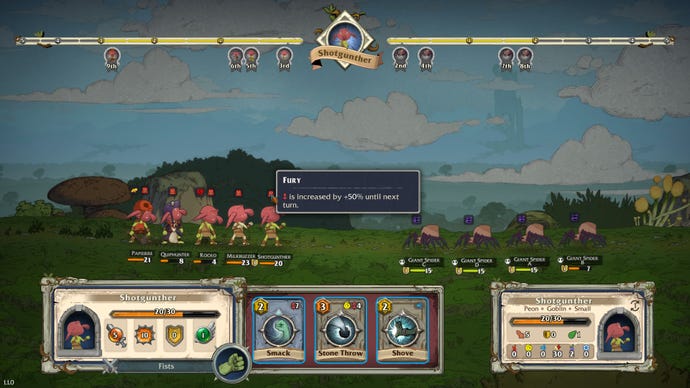
If you do get all your gobs killed by a band of nasty not-hobbits, though, you’ll still make progress. Not in terms of loot, which you’ll lose, but with souls. Alongside resources, souls are the major currency you’ll need to upgrade the lair. Veteran gobs are worth more souls, and you can retire them via a special room. They’ll hang around this way, growing long beards and letting you still breed them. Breeding is… not as fun as it sounds, honestly. You pick two gobbos with stats or traits you want to breed for, usually to get the best candidate for whatever class you’re after. Many of the traits are fairly rote, mainly related to stat modifiers. Most of the gobs look the same, too. No beards for your actual combat goblins. Maybe a different grin if you’re lucky. Missed opportunity? I mean, “goblin breeding is not that fun,” is a devastating sentence to have to write, yes.
Those classes are well considered, though, with lots of variety, and most importantly, a wide selection of fancy hats (it is me, the twee enjoyer). Your gobs feel puny individually, but deadly as a team, giving battles a suitably gob-like ‘death by a thousand cuts’ feel. Sometimes, quite literally. Your raider might inflict two bleed stacks with an upgraded throwing dagger, while a second picks those wounds to add another stack, then a third might unleash a devastating ‘blood rupture’, cashing in those stacks for huge instant damage. A stool-shield wielding guard might stun-whack a zombie, setting up the next raider in line for a ‘wakey wakey’ - a two hit combo that adds a third hit on stunned or slowed foes. Shamans can heal, guards can buff armour and tank hits, and other, secret classes might do some other, secret stuff, too. Again, it’s all about the team plays here.
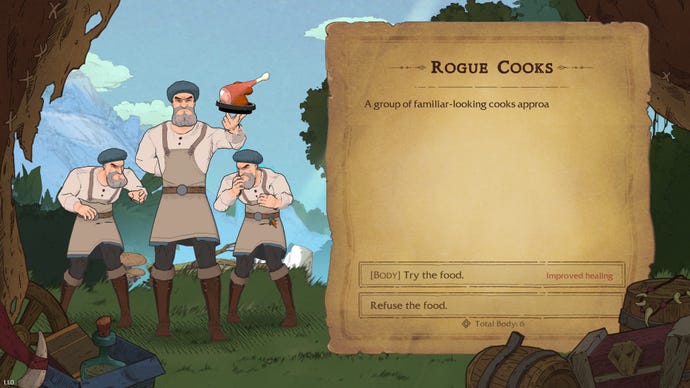
Goblin Stone’s best idea has nothing to do with goblins, but is also comparatively unsexy, at least next to those sexy, sexy goblins. I’ll call it the ‘time bar’. Both friend and foe move along the time bar, from outside to inside towards the middle, where they act. Along the bar are numbered pips. Each turn, you’ll pick from one of three abilities, randomly selected from a total of four. Each ability costs a certain number of pips, sending your gob to the back of the queue and that number of pips back on the bar. You’ll get the hang of this in about fifteen seconds. After another fifteen, you’ll learn to prize abilities that manipulate the bar, pushing foes back or stunning and slowing them. Bar manipulation is king here. Plan it right, and you can keep your foes stuck as you steal turn after turn. It’s a clean, readable bit of combat flow design that plays nicely into a great many abilities.
My problem with Goblin Stone is just how stodgy it all feels. You’ll want those lair upgrades to unlock advanced classes and other adventuring perks, but lair upgrades mean grinding, and grinding means hours of slow, repetitive combat. There’s something like eight abilities total for each of the nine classes, four of which you can equip each run, so things get flowchart-y very quickly. You can’t shorten combat animations. Gold, the most common reward, just isn’t that useful. A winning trick the best in the genre pull off is making the moment-to-moment progress feel as worthwhile as the bigger picture, but there’s no real deckbuilding or many permanent upgrades, so the micro rewards are scant and even the macro rewards aren’t that exciting, save new classes. It’s tiresome to realise you’ll have to do three runs or so to hit the next progress milestone, and even more so when those runs won’t offer much new.
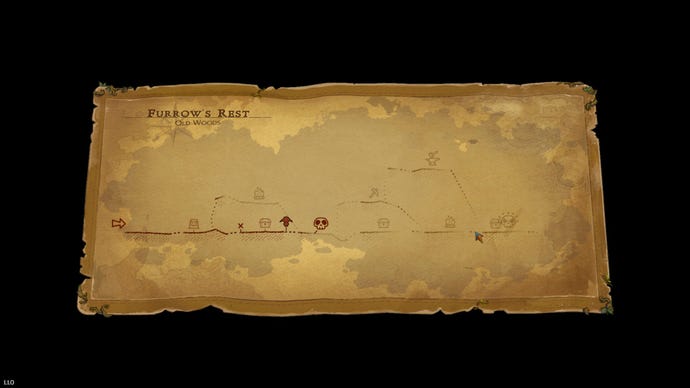
I do not need to tell you that Goblin Stone’s art direction is wonderful, nor that its UI delights me with its crispy cleanness. Less immediately obvious is the winking Bakshi-esque movement of the human enemies, or the parchment-sketched storybook interludes. The music is also lovely, all jaunty and bucolic, and the narrator narrates his heart out. But what you’ll want to ask yourself before deciding or not on GobStone is the sort of space you’d like the game to occupy. If you’re looking for your next Spire or Monster Train shaped obsession, ripe for long devoted evenings, I think you’ll hit a wall here much sooner than you’d like. 20 chill minutes a day over coffee though? Those problems are going to take a while to emerge, letting its charm stay potent for much longer. And, of course, it all comes down to how well that charm hits for you in the first place.
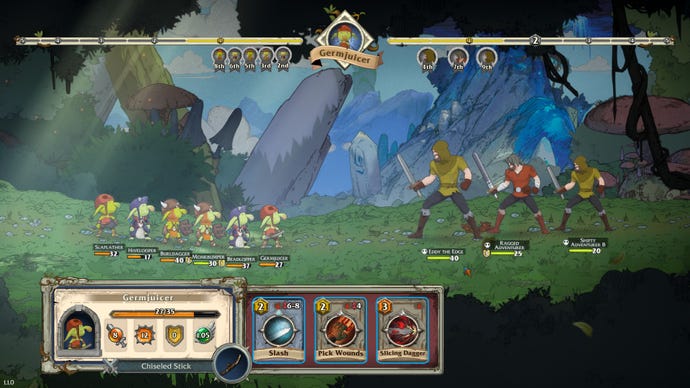
I’ve got a list of other gripes in place of the effusive praise I wanted to give here. You fight vanishingly few heroes for a good while after the introduction. I signed up for hero slaying, but this is all zombies, wolves, and spiders. I can slay these bastards anywhere. The game threatens a good idea in letting you collect healing items on quests that you can then sell if you don’t use. A potentially nice risk/reward that falls flat because, as I said, gold just isn’t that useful compared to how common it is. The main issue is that pacing, though. I’m left in a weird position where it’s too slow to really want to play much more than a pickup game here and there, but a single run just isn’t very satisfying, or tense, or tactically interesting either. So if I don’t want to play for a short while, and I don’t want to play for a long time, I suppose I don’t actually want to play at all? Shit. Sorry, gobs. Extinction it is, I guess.
This review was based on a copy of the game provided by the developer.
